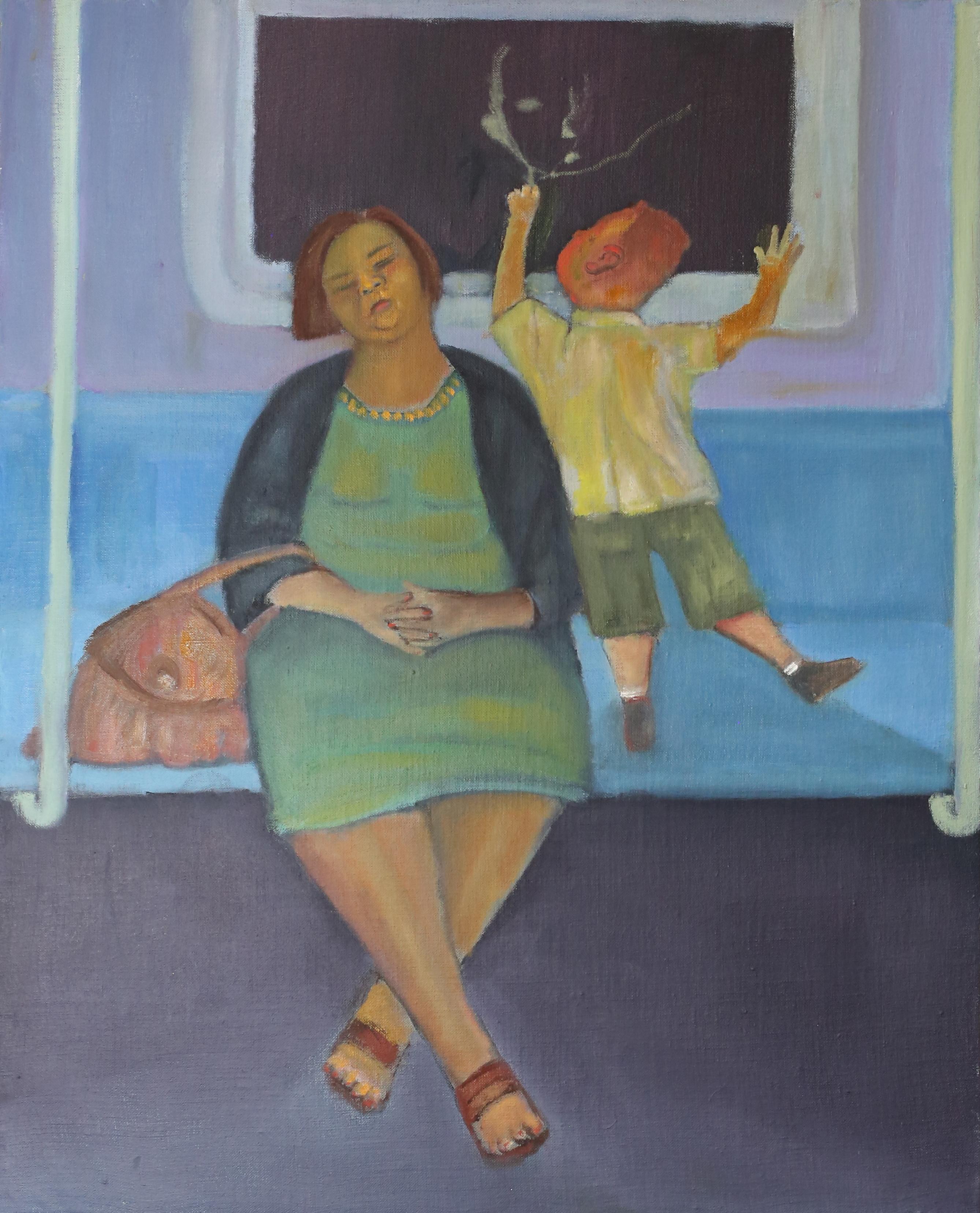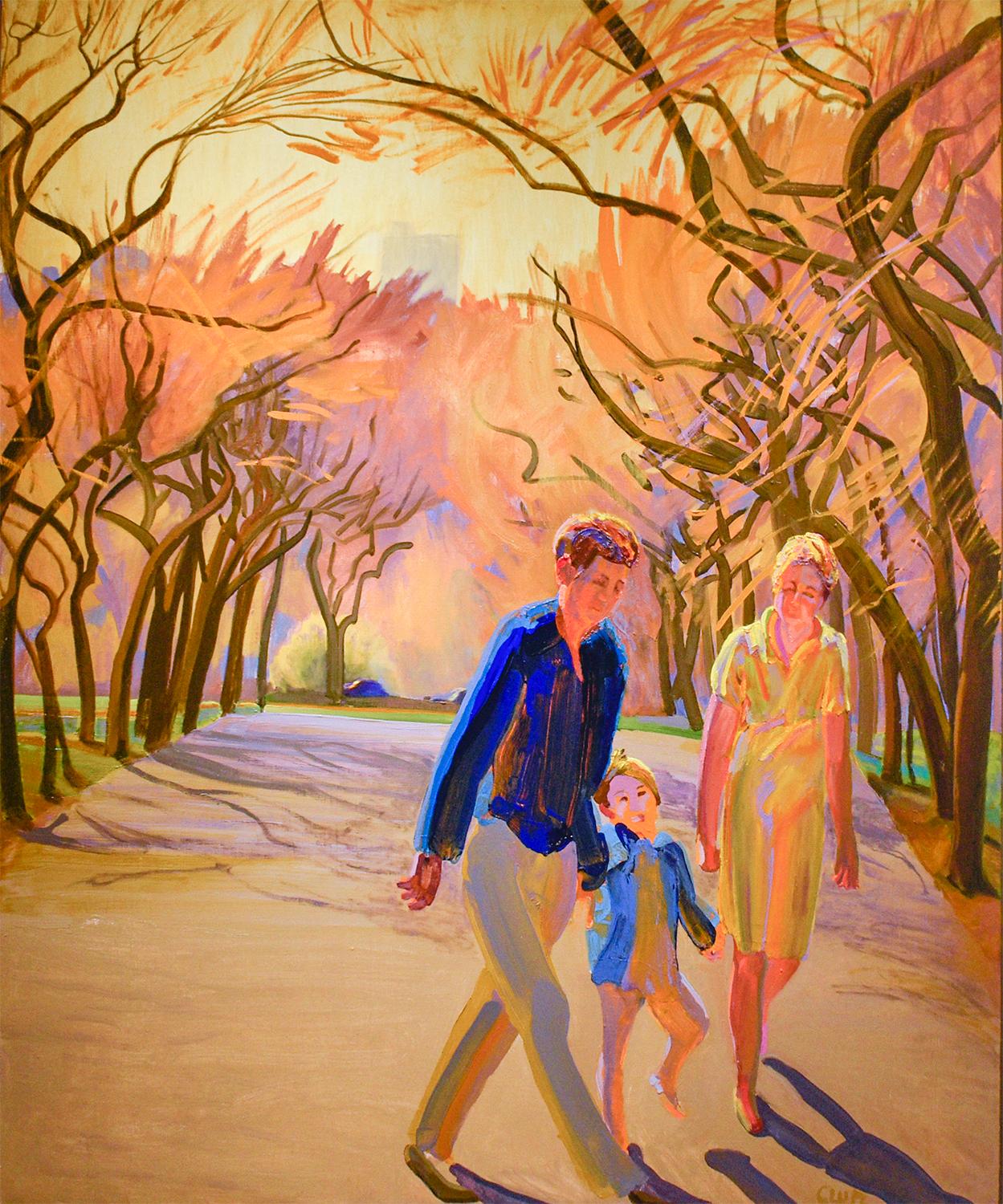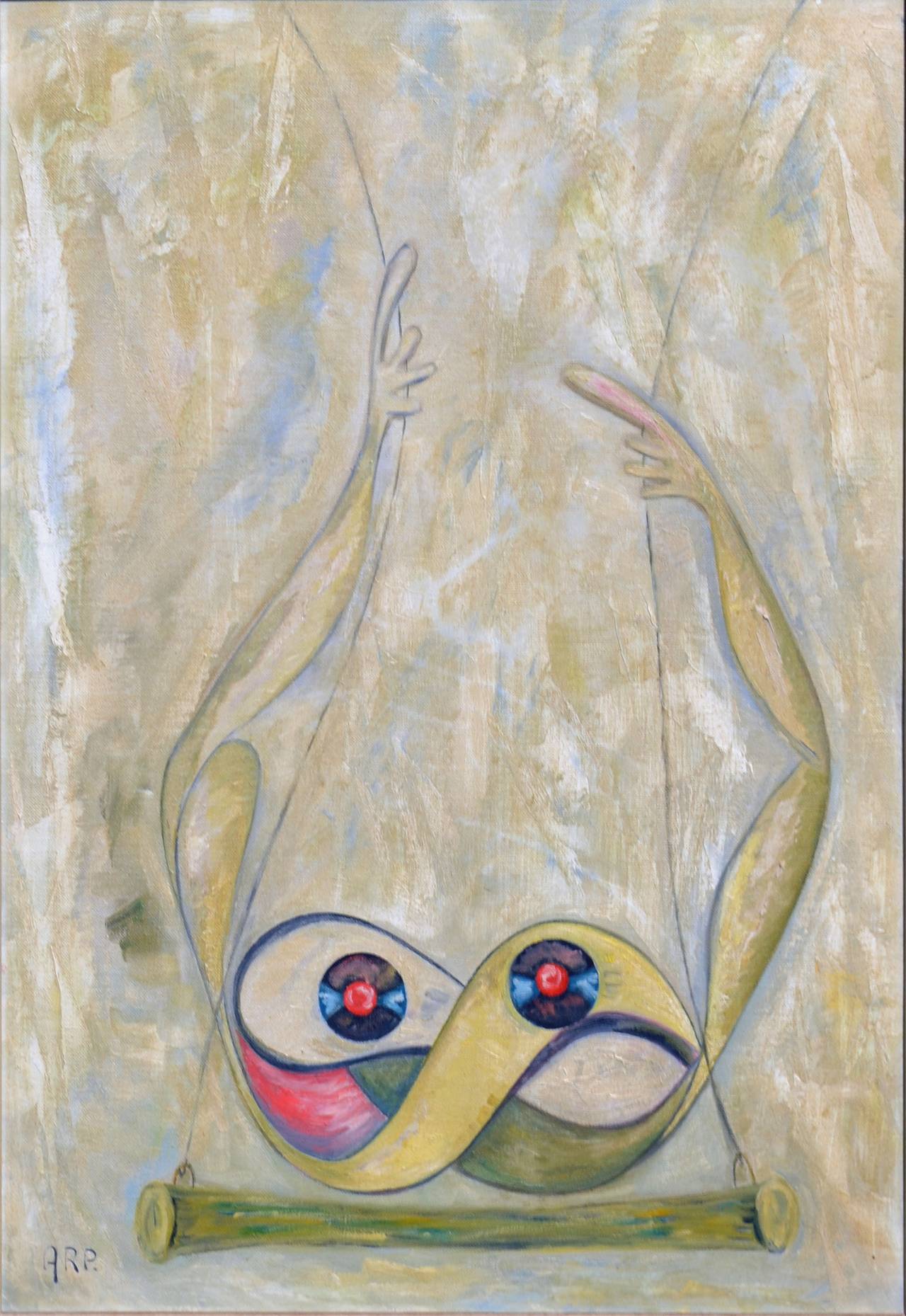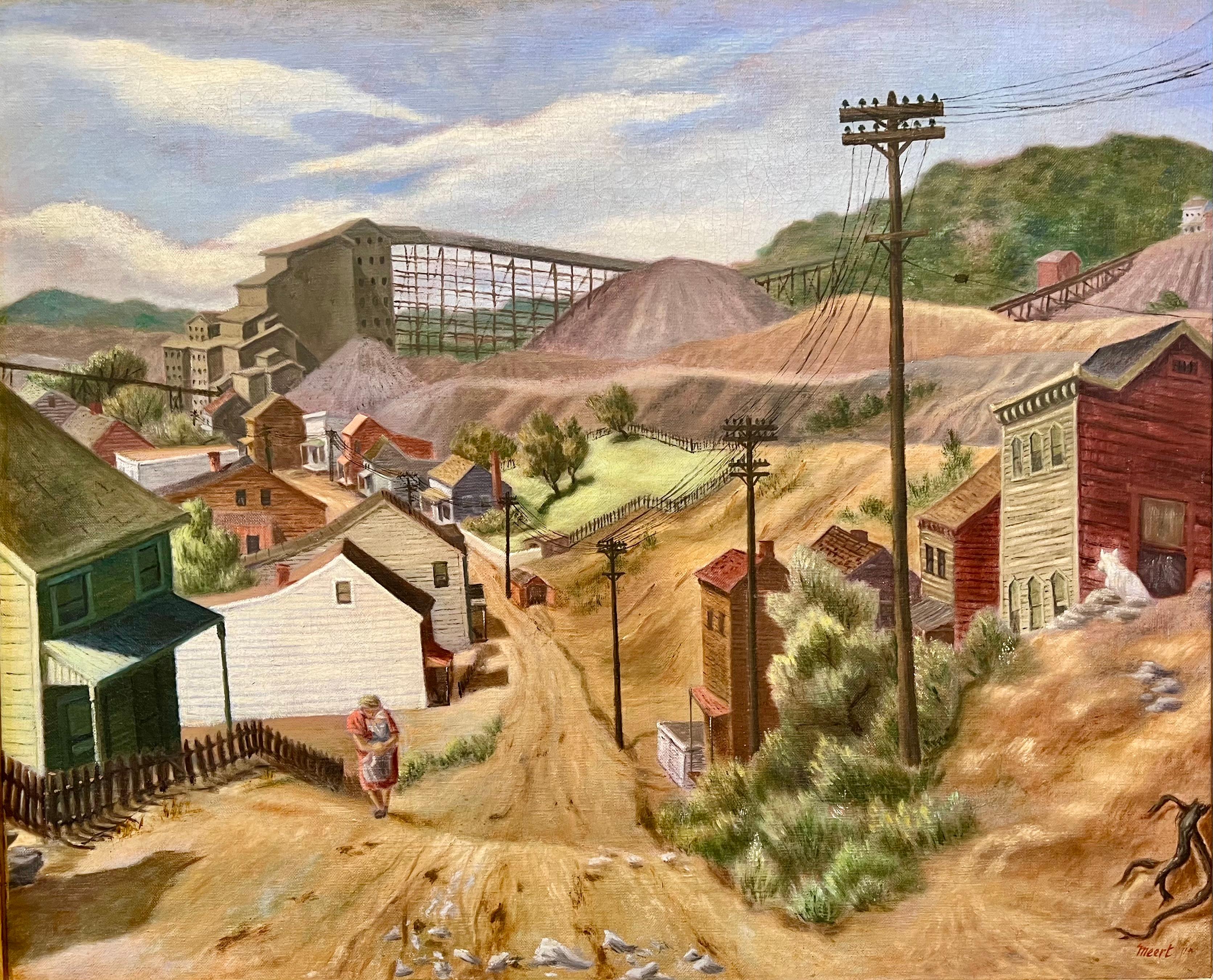Items Similar to Girl in Green
Want more images or videos?
Request additional images or videos from the seller
1 of 5
Donald S. VogelGirl in Green1942
1942
About the Item
Donald Vogel’s paintings reflect his interest in seeking beauty in life and in sharing pleasure with his viewers. Vogel entreats us to "rejoice and celebrate each new day, knowing it is a gift in itself, and produce something of worth to be shared. That is the life that has served this artist's pilgrimage."
Donald S. Vogel has been a set designer and technical director in the theater, a fine art dealer, and a writer, but first and foremost he is a painter. From a young age he was intrigued by the possibilities of creating images. The excitement and pleasure derived from the act of creation continued to be the force that compelled him to paint throughout his life.
Born in Milwaukee, Wisconsin, Donald S. Vogel began his formal art training at the Witte Memorial Museum in San Antonio when he was seventeen. His training, under the watchful eye of Eleanor Onderdonk, was briefly interrupted by a move to Washington, DC , where he took drawing classes at The Corcoran School of Art . He returned to San Antonio to finish high school and continued studying under Onderdonk. After graduation, he moved to Chicago in 1936 to enroll in The School of the Art Institute of Chicago. In the Impressionist and Post-Impressionist rooms of the Institute, a new world opened up to him, one that would forever influence the direction of his work. He saw art that dealt with the effects of atmosphere and light. The subjects and techniques used by these painters conveyed a sense of happiness, exuberance, and pleasure, which offered a stark contrast to the world outside stifled by the Great Depression.
While studying at the Art Institute, Vogel roomed at the Artist Community House where many students lived. This environment served as a counterpoint to the academic training he received at the Institute. It afforded the students the freedom to discuss issues in contemporary art, and freely experiment with unconventional ideas and techniques. Most importantly, this fertile environment intensified Vogel's commitment to paint.
Feeling the pinch of the Depression, Vogel left the Art Institute in 1940, and was accepted on the WPA Easel Project. This allowed him the luxury of drawing and painting from dawn to dusk. The freedom to paint at all hours focused his interest on the seemingly endless variations of light and atmosphere. With unlimited use of a model, he produced thousands of figure drawings until, eventually freed from the necessity of working from life, he began to paint purely from his imagination.
In 1942, Vogel moved to Dallas. The previous year, while he was still living in Chicago, the Dallas Museum of Fine Arts had given Vogel a one-person show; in 1943, shortly after his arrival in Dallas, the DMFA gave him another. While working first as a set designer and then as technical director at the Dallas Little Theater, Vogel spent his free time at the easel. During the 1940's he gained recognition in the art community by promoting the work of fellow artists and winning coveted purchase awards and prizes in the Texas General and Allied Arts Exhibitions for his own paintings.
In 1951, Vogel and his wife Peggy, alongside Dallas arts patron Betty McLean, opened the Betty McLean Gallery. It was the first gallery in Texas to deal in modern art on an international level. In 1954, the Vogels moved to a five-acre site north of Dallas and opened Valley House Gallery. The new setting at Valley House deeply inspired Vogel, serving as a source for ideas, and providing a place of serenity and contemplation.
Vogel's work is characterized by his love of color, and his fascination with the changing qualities of light. A favorite subject, often revisited during the latter part of his career, is the greenhouse. He first experimented with this subject in 1976, and began using it in earnest in 1978. Having worked in a hothouse during his youth, he found it a natural subject for exploring the effects of atmosphere, light, and color. Like Monet's pond at Giverny, Vogel's greenhouses have become his signature: an imaginary place of endless fascination.
Vogel produced many catalogues for gallery artists but he had never written for himself. In 1989, he penned two autobiographical short stories and published them under the title Charcoal and Cadmium Red. He found writing to be as challenging a process as painting. During his eighth decade, he wrote and painted with equal intensity.
“The agony and ecstasy I felt while producing each work was welcomed, as each required the other to fulfill the quest. And the quest remains to produce works that should delight the eye, give pause for thought, heighten the spirit, and sense the awareness of our being,” wrote Donald S. Vogel in 1998, on the occasion of his Retrospective exhibition and catalogue.
Donald S. Vogel's work is included in the following collections:
Art Institute of Chicago, Chicago, Illinois
Beaumont Museum of Fine Art, Beaumont, Texas
Charles Goddard Center, Ardmore, Oklahoma
Dallas Museum of Art, Dallas, Texas
Fine Arts Museum of the South, Mobile, Alabama
Ft. Worth Art Association, Ft. Worth, Texas
Old Jail Foundation, Albany, Texas
Panhandle-Plains Historical Museum, Canyon, Texas
Philadelphia Museum of Art, Philadelphia, Pennsylvania
Philbrook Art Center, Tulsa, Oklahoma
The Pennsylvania Trust, Radnor, Pennsylvania
Tyler Museum of Art, Tyler, Texas
Witte Museum, San Antonio, Texas
This painting is unframed; the price does not include a frame.
- Creator:Donald S. Vogel (1917-2004, American)
- Creation Year:1942
- Dimensions:Height: 20 in (50.8 cm)Width: 16 in (40.64 cm)
- Medium:
- Movement & Style:
- Period:
- Condition:
- Gallery Location:Dallas, TX
- Reference Number:
About the Seller
5.0
Recognized Seller
These prestigious sellers are industry leaders and represent the highest echelon for item quality and design.
Established in 1954
1stDibs seller since 2013
151 sales on 1stDibs
Typical response time: A week
Associations
Art Dealers Association of America
- ShippingRetrieving quote...Ships From: Dallas, TX
- Return PolicyA return for this item may be initiated within 2 days of delivery.
More From This SellerView All
- Releasing the DoveBy Fred NaglerLocated in Dallas, TXFred Nagler was born in 1891 in Springfield, Massachusetts, where he first studied wood carving. From 1914 to 1917, he studied at The Art Students League of New York, where his profe...Category
Mid-20th Century American Modern Figurative Paintings
MaterialsCanvas, Oil
- SchoolBy John HartellLocated in Dallas, TXValley House Gallery is honored to present a selection of paintings from the estate of American artist, John Hartell (1902-1995). John Hartell taught two disciplines at Cornell University in Ithaca, New York: freshman architecture and graduate painting. He was a much-loved professor there from 1930 until his retirement in 1967; one of his most illustrious students is the architect Richard Meier. As an artist, Hartell's first solo exhibition was in 1937 at Kleeman Gallery in New York. He exhibited at Kraushaar Galleries in New York for four decades, beginning in 1943. The Hartell Gallery at Cornell University, under the Sibley Dome, is named for him. In describing John Hartell, the artist Michael Boyd...Category
Late 20th Century American Modern Paintings
MaterialsCanvas, Oil
- Gray FloralBy Donald S. VogelLocated in Dallas, TXDonald Vogel’s paintings reflect his interest in seeking beauty in life and in sharing pleasure with his viewers. Vogel entreats us to "rejoice and celebrate each new day, knowi...Category
1960s American Modern Paintings
MaterialsCanvas, Oil
- Interior with FiguresBy Arthur OsverLocated in Dallas, TXArthur Osver studied at Northwestern University and the Art Institute of Chicago. Osver was awarded the Prix de Rome in 1952. He taught at the Brooklyn Museum Art School, Columbia Un...Category
1930s American Modern Interior Paintings
MaterialsOil, Canvas
- Portrait of Harriet Toby, Ballet Russe de Monte CarloBy Donald S. VogelLocated in Dallas, TXDonald Vogel’s paintings reflect his interest in seeking beauty in life and in sharing pleasure with his viewers. Vogel entreats us to "rejoice and celebrate each new day, knowing it...Category
1940s American Modern Figurative Paintings
MaterialsOil, Panel
- Portrait of Kevin's playmateBy Donald S. VogelLocated in Dallas, TXDonald Vogel’s paintings reflect his interest in seeking beauty in life and in sharing pleasure with his viewers. Vogel entreats us to "rejoice and celebrate each new day, knowing it...Category
Mid-20th Century American Modern Portrait Paintings
MaterialsOil, Panel
You May Also Like
- The Budding Artist urban narrative muted blue colors subway sceneBy Stephen BassoLocated in Brooklyn, NYOil on linen mounted on board signed and dated on reverse.Category
2010s American Modern Figurative Paintings
MaterialsLinen, Board, Oil
- Park Spring (Impressionistic Figurative Painting of Figures in a Park Landscape)By William ClutzLocated in Hudson, NYModern impressionist style figurative painting of a family in a colorful park landscape “Park Spring” painted by William Clutz in 1996 60 x 50 inches in a natural wood floater frame Wire backing, signed lower right This figurative oil on canvas painting was made in 1996 by William Clutz as part of a series of works called "Crossings". These paintings were a study of NYC dwellers engaging in the simple, daily activity of crossing the street. In this piece, Clutz captures a joyful moment of a mother and father walking in a sunlit park landscape with their young child. Bright sunlight radiates through lush fall foliage and fills the scene with a soft orange light. With broad, expressionistic brushstrokes, he discovers the extraordinary in the ordinary, by emphasizing the effects of sunlight on the human form. The painting is in excellent condition and is framed in a natural wood floater frame. More about the artist: In New York in the early 50's and 60's, abstract expressionism was the orthodox approach to art at the time. However, Clutz was committed to his personal style that focused on abstracted human figures within urban tableaux. Working in a context of artists who challenged abstract expressionism's popularity in New York, Clutz established himself as a significant proponent of abstract figuration. His paintings focus on human figures within the urban environment, often exposing the transfiguration of his subjects as they travel through the complex light of city streets or summer parks, as shown in two of his early works. Clutz's interest in working from direct observation of urban life was influenced by a long-standing interest in German Expressionism, as well as artists like Henri Matisse, Arshile Gorky, and Nicholas De Stael...Category
1990s American Modern Figurative Paintings
MaterialsOil, Linen
- Mid-Century Modern Abstract Geometric Trapeze Artists by Hilda ArpBy Hilda ArpLocated in Soquel, CAFanciful mid-century modern abstract of trapeze artists by Brooklyn artist Hilda Dora Pape Arp (b. 1909). This 1962 highly abstracted depiction of trape...Category
1960s American Modern Abstract Paintings
MaterialsOil, Linen
- Valentine Couple older tattooed man and woman valentine love theme warm colorBy Stephen BassoLocated in Brooklyn, NYThis is a recently completed oil painting created for valentines day. It is painted on linen canvas mounted on a cradled wood panel. Framing suggested but not required. It is signed...Category
2010s American Modern Figurative Paintings
MaterialsWood, Oil, Linen
- Six O'ClockLocated in Los Angeles, CASix O-Clock, c. 1942, oil on canvas, 30 x 20 inches, signed and titled several times verso of frame and stretcher (perhaps by another hand), marked “Rehn” several times on frame (for the Frank K. M. Rehn Galleries in New York City, who represented Craig at the time); Exhibited: 1) 18th Biennial Exhibition of Contemporary American Oil Paintings from March 21 to May 2, 1943 at The Corcoran Gallery of Art in Washington, D.C. #87, original price $450 (per catalog) (exhibition label verso), 2) Craig’s one-man show at the Frank K. M. Rehn Galleries, New York City, from October 26 to November 14, 1942, #10 (original price listed as $350); and 3) Exhibition of thirty paintings sponsored by the Harrisburg Art Association at the State Museum of Pennsylvania in Harrisburg in March, 1944 (concerning this exhibit, Penelope Redd of The Evening News (Harrisburg, Pennsylvania) wrote: “Other paintings that have overtones of superrealism inherent in the subjects include Tom Craig’s California nocturne, ‘Six O’Clock,’ two figures moving through the twilight . . . .” March 6, 1944, p. 13); another label verso from The Museum of Art of Toledo (Ohio): original frame: Provenance includes George Stern Gallery, Los Angeles, CA About the Painting Long before Chris Burden’s iconic installation outside of the Los Angeles County Museum of Art, Urban Light, another artist, Tom Craig, made Southern California streetlights the subject of one of his early 1940s paintings. Consisting of dozens of recycled streetlights from the 1920s and 1930s forming a classical colonnade at the museum’s entrance, Burden’s Urban Light has become a symbol of Los Angeles. For Burden, the streetlights represent what constitutes an advanced society, something “safe after dark and beautiful to behold.” It seems that Craig is playing on the same theme in Six O-Clock. Although we see two hunched figures trudging along the sidewalk at the end of a long day, the real stars of this painting are the streetlights which brighten the twilight and silhouette another iconic symbol of Los Angeles, the palm trees in the distance. Mountains in the background and the distant view of a suburban neighborhood join the streetlights and palm trees as classic subject matter for a California Scene painting, but Craig gives us a twist by depicting the scene not as a sun-drenched natural expanse. Rather, Craig uses thin layers of oil paint, mimicking the watercolor technique for which he is most famous, to show us the twinkling beauty of manmade light and the safety it affords. Although Southern California is a land of natural wonders, the interventions of humanity are already everywhere in Los Angeles and as one critic noted, the resulting painting has an air of “superrealism.” About the Artist Thomas Theodore Craig was a well-known fixture in the Southern California art scene. He was born in Upland California. Craig graduated with a degree in botany from Pomona College and studied painting at Pamona and the Chouinard Art School with Stanton MacDonald-Wright and Barse Miller among others. He became close friends with fellow artist Milford Zornes...Category
1940s American Modern Landscape Paintings
MaterialsCanvas, Oil
- Gold Mine, Central City, ColoradoBy Joseph MeertLocated in Los Angeles, CAThis painting is part of our exhibition America Coast to Coast: Artists of the 1930s Goldmine, Central City, Colorado, oil on canvas, 36 x 28 inches, c. 1936, signed lower right, ex collection of Platt Fine Art, Chicago, Illinois (label verso). About the Painting Joseph Meert’s painting, Goldmine, Central City, Colorado, depicts the short-lived resurrection of a once prominent city just outside Denver. Central City was founded in 1859 soon after John Gregory struck gold in the area. As word spread, thousands of miners converged into “Gregory’s Gulch” and its surroundings became known as the “richest square mile on earth.” Mining production quickly increased resulting in Central City to becoming Colorado’s largest city in the early 1860s. Despite some technical difficulties transitioning to lode mining and the rise of competition from Leadville, Central City remained an economic boom town through the turn of the century. But, with every boom, there is a bust. World War I marked the end of Central City’s prominence as ore production ground to a halt and by 1925, the town’s population shrank to only 400 people. The desperation of the Great Depression and a nearly 100% increase in the price of gold lured labor and capital back to Central City. Meert painted in Colorado during the mid-1930s, a time when he created his most desirable works. It is during this period of renaissance that Meert captures one of Central City's outlying dirt streets bordered by 19th century wooden houses from the town's heyday and the more recently installed electric lines leading to a distant gold mine. A lone figure trudges up the hill, a mother with a baby in her arms, putting us in mind of the rebirth of the town itself. Meert had solo exhibitions at the Colorado Springs Fine Arts Center in 1936 and the Denver Art Museum. Although it is not known whether Goldmine, Central City was included in either of these exhibitions, it seems likely. Moreover, the painting is closely related to Meert’s painting, The Old Road, which was painted in 1936 and exhibited at the Corcoran Gallery of Art in Washington, DC and at the Dallas Museum of Art. About the Artist Joseph Meert was a well-regarded painter and muralist, who initially made a name for himself in the American Scene and later as an abstract expressionist. Although initially successful, Meert struggled financially and with mental illness later in life. He was born in Brussels, Belgium, but moved with his family to Kansas City, Missouri. As a child, a chance encounter at the Union Pacific Railyard changed his life. Meert happened upon a worker repainting and stenciling a design on a railroad car. Meert later recalled that this experience introduced him to the idea of being a painter. Without support from his father, Meert obtained a working scholarship to the Kansas City Art Institute. After four years at the Kansas City Art Institute, Meert studied seven years at the Art Students League and in Europe and Los Angeles. At the Art Students League, Meert fell under the spell of Thomas Hart Benton and Stanton MacDonald-Wright. In 1931, he befriended Jackson Pollock. By 1934, Meert was part of the Public Works of Art Project when he met his wife, Margaret Mullin...Category
1930s American Modern Landscape Paintings
MaterialsCanvas, Oil





